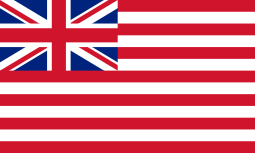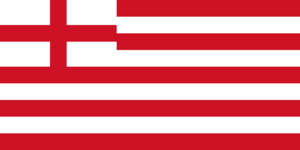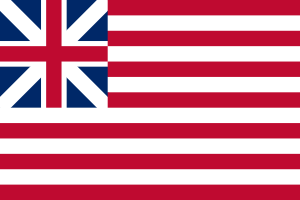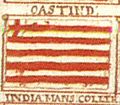Flag of the East India Company facts for kids
 |
|
| Use | Company flag and ensign |
|---|---|
| Adopted | 1801 |
| Relinquished | 1858 |
| Design | Thirteen horizontal stripes alternating red and white with the Flag of the United Kingdom in the canton |
The flag of the East India Company was a special flag used by the East India Company. This powerful trading company was started in England in 1600.
Over time, the flag changed as England became Great Britain and then the United Kingdom. It first had red and white stripes with the flag of England in the corner. This corner part of a flag is called the canton. Later, the flag in the canton was updated to show the flag of Great Britain and then the flag of the United Kingdom.
Contents
Early Days of the Flag

In 1600, Queen Elizabeth I of England gave the English East India Company a special permission, called a Royal Charter. This allowed them to trade in the Indian Ocean. For their flag, they chose red and white stripes, usually between nine and thirteen of them. In the canton, they placed the flag of England.
This flag caused some trouble for the Company when they traded in the Far East. The Saint George's Cross on the flag was seen as a Christian symbol. In Japan in 1616, the Company's ships were turned away. This was because Japan had banned Christianity in 1614. The Lê dynasty in Tonkin (part of modern-day Vietnam) also banned the flag. They thought the cross meant the Company was promoting Christianity, which they had forbidden.
The Dutch East India Company, who were rivals, tried to help. They argued that the cross was a symbol of England, not Christianity. But the Tonkinese still insisted the flag could not be flown unless the cross was removed. In 1673, when the Company tried to trade with Japan again, they first refused to change their flag. However, after getting advice and a demand from Japanese officials, they started using a flag with just red and white stripes, without the English flag, for trading in the Far East.
In 1682, in Batavia, Dutch East Indies (now Jakarta), the Company's flag caused tension. Soldiers from the Dutch East India Company were accused of tearing down one of the English Company's flags. Even though the Dutch sent warships, nothing serious happened. The person who made the accusation wasn't there, and neither the Company leaders nor King Charles II of England wanted a fight with the Dutch over it.
The Flag of Great Britain

In 1603, King James VI of Scotland also became King of England. This event, called the Union of the Crowns, brought the two countries closer. He created a new flag combining the flags of England and Scotland. This was meant for a united British state. However, the parliaments of England and Scotland wanted to stay separate. So, the King kept his new flag, known as the King's Colours, for his own use.
The East India Company continued to use their flag with the English flag in the canton. In 1668, King Charles II of England gave control of Mumbai to the East India Company. The Company then updated its flag to include the King's Colours. This was shown when they asked for blue cloth, along with red and white, for a new flag for the fort in Bombay. The King's Colours officially became the flag of Great Britain when the Kingdom of Great Britain was formed in 1707. This happened because of the Acts of Union 1707, pushed by Anne, Queen of Great Britain.
How it Compares to the American Flag

Many people believe the flag of the East India Company helped inspire the Grand Union Flag of 1775. This was the first flag of the United States. The two flags looked very similar.
Benjamin Franklin, a famous American leader, once suggested that the United States use a flag like the Company's. He told George Washington, "While the field of your flag must be new in the details of its design, it need not be entirely new in its elements. There is already in use a flag, I refer to the flag of the East India Company." This idea showed that Americans were still loyal to the British Crown. But it also showed their hope to govern themselves, just like the East India Company did in some ways. Some American colonists also thought the Company could be a strong friend in the American War of Independence. They felt the Company had similar goals and complaints about the Crown's tax rules. So, some colonists flew the Company's flag to show their support.
However, some historians say there isn't much written proof that the Grand Union Flag directly came from the East India Company flag. Still, the flags look very alike. Also, many of the Founding Fathers of the United States knew a lot about the East India Company. They knew how the Company managed India on its own.
The Flag of the United Kingdom
In 1801, Great Britain and the Kingdom of Ireland joined together to form the United Kingdom of Great Britain and Ireland. Because of this, the Union Flag (the British flag) was changed to include Saint Patrick's Saltire (a red X-shape for Ireland).
So, the East India Company's flag was updated again. It now showed the new Union Flag in its canton.
In 1858, the British government passed the Government of India Act 1858. This law took over all the East India Company's land and power in India. This process is called Nationalisation. India then became part of the British Raj, which was direct British rule. This meant the Company rule in India ended. With that, the East India Company flag no longer had any official use.
Gallery
See also






